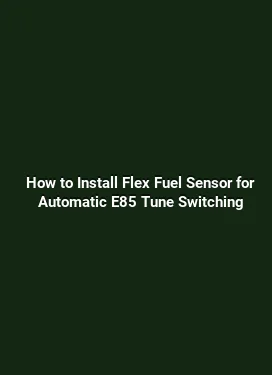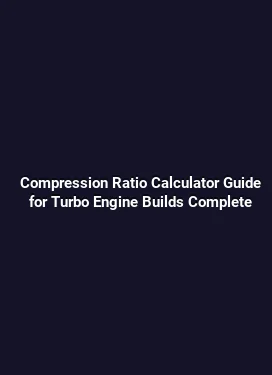The Future is Over-The-Air: How Remote ECU Tuning is Changing Performance Upgrades
Engine management and tuning have long been domains of hands-on calibration, dyno sessions, and physical access to the vehicle’s control units. Today, advances in wireless connectivity and edge computing are enabling a dramatic shift toward over-the-air (OTA) tuning. Remote ECU tuning allows engineers and enthusiasts to push performance boundaries without frequent shop visits, fostering rapid iteration, safer parameter adjustments, and broader access to optimized calibrations. This article delves into how OTA tuning works, the key components involved, practical workflows, safety considerations, and how to evaluate the right approaches for different platforms and goals.
What OTA Tuning Means for Modern Vehicle Electronics

Over-the-air tuning refers to the process of delivering, applying, and validating engine calibration updates through wireless communication rather than direct, physical interfacing with an ECU. In modern vehicles, ECUs are highly capable, networked systems that manage fuel delivery, ignition timing, boost control, variable valve timing, and more. OTA enables calibrated maps to be updated after vehicle production, during a race-weekend, or after a performance event. This capability hinges on secure data transfer, robust cryptographic validation, and reliable on-vehicle execution environments that can apply updates without compromising safety or drivability.
From a performance perspective, OTA unlocks several benefits. First, calibration teams can implement refined fuel and ignition curves, torque limits, and exhaust gas recirculation (EGR) strategies with rapid feedback cycles. Second, OTA enables hierarchical tuning: owners can receive baseline enhancements that remain safe for daily driving, while professional teams push more aggressive maps for track conditions. Third, over-the-air updates support regulatory compliance by ensuring updated calibrations can incorporate current emission controls and diagnostic protocols as conditions change or new standards emerge. Collectively, these capabilities accelerate development timelines and empower a broader community of tuners and enthusiasts.
Key Components and Workflow of OTA ECU Tuning
Implementing OTA tuning involves a layered architecture that ensures secure, reliable delivery of calibration data from a central repository to the vehicle’s ECU, followed by safe application and validation. Understanding these components helps practitioners design robust workflows that minimize risk and maximize performance gains.
Secure Communication Protocols and Authentication

Security is foundational to OTA tuning. Modern systems employ mutual authentication, encryption in transit (such as TLS) and at rest, and code signing to prevent unauthorized access or tampering. The ECU typically requires a valid digital signature for any calibration payload, and the vehicle’s telematics module (or a dedicated device) verifies certificates before initiating an update. This prevents rogue calibrations from being installed, which could otherwise compromise engine safety, drivability, or emissions compliance.
Beyond cryptography, secure provisioning often includes roll-back capabilities. If an update fails or causes unexpected behavior, the system must revert to the last known good calibration or a safe fallback map. This safeguard is critical to avoid stranded vehicles or dangerous drivability issues during or after an OTA session.
Calibration Payloads and Versioning
Calibration payloads are structured sets of parameter adjustments that may touch fueling tables, ignition timing, boost targets, turbo wastegate rules, transmission shift points, torque limits, and auxiliary systems. Versioning ensures traceability across updates, enabling engineers to compare maps, assess the impact of each change, and revert if necessary. A well-managed catalog includes metadata such as vehicle model, engine type, fuel quality, ambient conditions, and intended use case (daily driving, hot-lapping, or endurance testing).
Practical practice involves modular payload design. Separate modules for fuel maps, ignition, boost/clamp limits, and rev limits allow targeted updates without regenerating entire calibrations. This modularity also aligns with scenarios where one module is updated due to a sensor change while other modules remain stable, reducing risk during deployment.
Delivery Channels and In-Vehicle Execution
OTA updates can ride over cellular networks, Wi-Fi, or dedicated telemetry links depending on availability and data costs. The delivery channel is chosen to balance speed, reliability, and data integrity. On receipt, the vehicle's ECU management software verifies the payload, allocates a staging area, and performs a staged application. Many systems implement a dual-partition approach: one partition holds the active calibration, while the other stores the incoming update. A successful flash switches the system after integrity checks, while a failed attempt triggers a fall-back to the previous stable state.
From a practical standpoint, practitioners should plan for scenarios where cellular coverage is intermittent. Local fallback modes, pre-downloaded baselines, and the ability to perform updates via a dealer diagnostic tool or a portable gateway help maintain momentum without leaving a vehicle immobilized.
Strategies for Safe and Effective Remote Tuning
Remote tuning introduces powerful capabilities, but it also demands disciplined methodologies. The following strategies help ensure that OTA tuning yields real-world performance improvements without compromising reliability or warranty considerations.
Baseline Assessment and Data-Driven Maps
Effective tuning starts with a thorough baseline assessment. Collect data from the stock configuration across a range of operating conditions: idle, partial load, full load, cold start, and hot ambient scenarios. Diagnostic data such as sensor feedback, injector latency, and juggle between the diverse operating modes gives insights into where tuning can safely apply. The goal is to create data-driven maps that reflect actual engine behavior rather than theoretical models. This reduces the risk of detonation, knock, or unintended fuel-rich conditions that could harm components.
Advanced practitioners leverage live data logging during controlled tests, then translate insights into calibrated adjustments. OTA platforms can disseminate these maps to multiple vehicles with consistent versioning, enabling fleet-wide improvement while preserving each vehicle’s unique hardware tolerances.
Gradual Rollouts and Safety Nets
One core practice is to implement gradual rollouts. Instead of pushing a full upgrade to every vehicle, begin with a small subset of units, monitor performance and reliability, then expand to larger groups. This phased approach helps detect edge cases and sensor anomalies that might not appear in isolated tests. Safety nets such as maximum torque limits, conservative boost boundaries, and fail-safe fuel trims should be embedded in every update. If data indicates instability, the system can automatically constrain the update or pause deployment until issues are resolved.
Additionally, consider creating tiered calibration programs: a street-safe map for daily use, a performance-oriented map for events, and an endurance-focused map for long sessions. OTA can switch between these modes through predefined conditions or user selection, with safeguards to ensure smooth transitions between maps under varying engine loads.
Emissions Compliance and Diagnostics
Public and regulatory expectations require that tuning remains within emissions frameworks. OTA systems must preserve proper sensor feedback loops, catalytic efficiency, and diagnostics that trigger fault codes when components underperform or drift outside expected ranges. This means that calibrations should be designed with diagnostic compatibility in mind, ensuring that updated maps do not mask underlying faults or disable required emission controls. Documentation and traceability of each calibration step help maintain compliance and provide a clear audit trail for inspections or warranty considerations.
For performance-focused users, it’s essential to align tuning changes with sensor realities. Aggressive fueling or timing that ignores oxygen sensor feedback will quickly lead to rich mixtures or pre-ignition. OTA workflows should include checks that validate sensor data coherence after each update, and safety thresholds that can detect sensor malfunctions before drivability is affected.
Practical Use Cases: From Street Tuning to Track-Ready Setups
Remote ECU tuning is not just a theoretical concept; it translates into tangible benefits across various use cases. Here are practical scenarios that illustrate how OTA tuning is reshaping performance upgrades.
Baseline Street Tuning with Remote Enhancements
In daily-driver contexts, OTA updates can deliver modest horsepower gains, improved throttle response, and smoother transmission behavior without compromising reliability. A baseline street map may optimize ignition timing for common fuel grades, adjust airflow metering to reduce pump gas knock tendencies, and fine-tune fuel trims during part-throttle cruising. Remote updates allow owners to receive periodic refinements as emissions software evolves, ensuring a vehicle remains optimized over its lifespan without repeated shop visits.
Owners can also opt into optional performance packages that activate more assertive fuel and timing strategies under specific load and RPM windows, with automatic back-off if sensor feedback indicates saturation or knock. This approach preserves drivability while delivering meaningful performance improvements in real-world driving scenarios.
Track-Ready Calibrations and Safety Margins
On the track, performance dials up the need for precise and repeatable maps. OTA enables teams to deploy track-specific calibrations that maximize power delivery within safe envelope windows. For example, boost control maps can be tuned for stability under sustained high RPM operation, while fuel and ignition maps are adjusted to maintain optimal air-fuel ratios across elevated ambient temperatures and high-load conditions. The OTA process also supports rapid iteration between sessions, letting engineers refine strategies based on data from the latest run and deploy updates overnight for the next session.
Critical to track tuning is data integrity. Telemetry packages feed live data into the calibration platform, where analysts compare lap times, trap speeds, and exit RPM data to the updated maps. If any anomaly appears—such as unexpected fuel trims or timing pull during high-load events—the update can be paused, and a safe rollback map is deployed until the root cause is resolved.
Fleet-Wide Upgrades and Standardization
For fleet owners, OTA tuning brings standardization and efficiency. A central tuning team can publish a suite of calibrated maps tailored to different vehicle configurations in the fleet, ensuring consistent performance characteristics while respecting hardware limitations. This approach reduces downtime, improves maintenance predictability, and enables data-driven decision-making about which upgrades deliver the most value per vehicle category.
Moreover, OTA updates can be aligned with service intervals, allowing new calibration strategies to be deployed alongside routine maintenance. This synchronized approach minimizes administrative overhead and ensures that each vehicle benefits from the latest refinements without manual, vehicle-by-vehicle interventions.
Challenges and Considerations for Adopters
While OTA tuning offers substantial benefits, it also presents challenges that practitioners must address to ensure long-term success and reliability.
Hardware Compatibility and Vehicle Diversity
ECU architectures vary widely across manufacturers and even within model generations. Some ECUs expose calibrations through well-documented interfaces, while others rely on proprietary protocols. Adopters must assess hardware compatibility, including the availability of secure upgrade channels, the presence of diagnostic interfaces, and the resilience of the vehicle’s software stack against OTA disruptions. Planning for a range of platforms, from naturally aspirated engines to turbocharged setups with sophisticated turbo control, ensures broad applicability of OTA strategies.
To manage this complexity, calibration teams often maintain a matrix that maps vehicle variants to supported OTA payload modules, ensuring that updates are targeted and safe for each configuration.
Warranty Coverage and Legal Considerations
Remote tuning can interact with warranty terms, service agreements, and local regulations. It’s essential to be transparent about what changes are deployed and to document the calibration lineage. Some manufacturers restrict certain types of edits or require that the vehicle be enrolled in a permitted program for remote updates. Engaging with customers on a clear consent basis and providing detailed change logs helps mitigate warranty and liability concerns while preserving user confidence in the process.
Additionally, regional emission requirements and compliance testing can influence how aggressively maps can be tuned. Keeping changes within regulatory expectations is critical to avoid unintended consequences during inspections or audits.
Data Privacy and Ownership
OTA tuning involves data that can include performance metrics, driving behavior patterns, and system diagnostics. Establishing clear data governance—what data is collected, how it is used, and who owns it—builds trust with vehicle owners and aligns with privacy expectations. Encryption, access controls, and transparent data usage policies are essential components of a responsible OTA ecosystem.
Future Trends: What to Expect in OTA Tuning
The evolution of OTA tuning is closely tied to advances in connectivity, artificial intelligence, and edge computing. Expect tighter integration between vehicle telemetry, real-time analytics, and calibration repositories. AI-driven models may propose safe, high-performance calibrations based on aggregated fleet data, climate conditions, fuel quality, and wear patterns, with human oversight to validate and approve updates before deployment. Additionally, as sensor suites become more comprehensive, OTA platforms will be able to fine-tune calibrations more precisely, balancing performance with durability and efficiency across diverse driving scenarios.
As industry ecosystems mature, standardized interfaces and open telemetry formats could reduce integration friction, enabling independent tuners to participate more broadly in remote upgrade programs. This democratization may catalyze innovative performance strategies while maintaining the prudent safeguards that ensure reliability and regulatory adherence.
Adopting OTA Tuning: A Practical Roadmap
For practitioners looking to deploy OTA tuning, a practical roadmap includes: establishing secure infrastructure, validating a baseline data set, designing modular payloads, implementing phased rollouts, and creating robust rollback mechanisms. Start with a small pilot fleet to validate end-to-end workflows, then iteratively expand to more vehicles and calibration options. Continuously monitor performance metrics, fault codes, and drivability indicators to ensure ongoing safety and reliability while pursuing performance gains.
Ultimately, the shift toward over-the-air ECU tuning represents a maturation of performance upgrades—one where data-driven decisions, secure delivery, and disciplined deployment practices unlock sustained, real-world improvements without the logistical burden of traditional dyno days or bench tuning. The result is a more agile, accessible, and responsible paradigm for enhancing engine management and overall driving experience.






